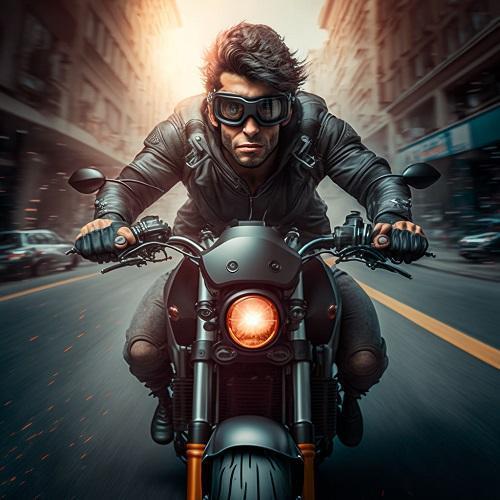Riding a motorcycle can be a thrilling experience, but it also comes with its own set of risks. Whether you’re a seasoned rider or just starting out, it’s essential to stay safe on the road by following these 10 motorcycle safety tips:
- Wear Proper Gear: Always wear a DOT-approved helmet and other protective gear, such as gloves, boots, and a jacket with reinforced padding. Wearing the appropriate gear can greatly reduce your risk of injury in the event of a crash. A helmet is the single most important piece of safety equipment for a motorcycle rider. It’s also important to make sure that your gear is in good condition and fits properly. A helmet that’s too loose or too tight won’t provide the protection you need. Make sure that your helmet fits snugly and that there’s enough space between your face and the helmet for your glasses or goggles. Also, ensure that your gloves and boots are made of sturdy materials and that they fit properly.
- Take a motorcycle safety course: Learn the basics of riding, as well as advanced techniques for handling different road conditions and situations. A motorcycle safety course will teach you the basics of motorcycle operation, as well as advanced techniques for handling different road conditions and situations. It will also give you the opportunity to practice your skills in a controlled environment. In addition to teaching you the basics of motorcycle operation, a safety course will also cover topics such as defensive riding strategies, emergency braking, and crash avoidance. Many states offer motorcycle safety courses, and some even offer them for free. Even experienced riders can benefit from taking a refresher course to brush up on their skills and learn about new technologies and safety features.
- Check your motorcycle before riding: Make sure your lights, brakes, and tires are in good working order, and that all fluid levels are at the proper levels. This is an important step that should be done before every ride. It’s important to ensure that your motorcycle is in good working condition and that all fluid levels are at the proper levels. This includes checking the oil, brake fluid, and coolant levels. Also, make sure that your tires have enough tread and are properly inflated. Check your brakes to ensure they are working properly and that the pads are not worn. Check your lights to ensure they are working properly and that the bulbs are not burnt out. Perform these checks each time before you ride to ensure the safety of yourself and others on the road.
- Stay visible: Use your headlights and wear bright or reflective clothing to make yourself more visible to other drivers. Motorcycles are smaller and less visible than cars, so it’s important to take extra precautions to make yourself more visible to other drivers. Always use your headlights, even during the day, to increase your visibility. In addition to using your headlights, you should also wear bright or reflective clothing. This will help you stand out on the road and make it easier for other drivers to see you. Reflective vests, jackets, and pants are a good choice, and many motorcycle gear manufacturers offer products with built-in reflective elements.
- Be aware of your surroundings: Keep an eye out for hazards such as potholes, debris, and other vehicles on the road. Being aware of your surroundings is essential to staying safe on a motorcycle. Always keep an eye out for potential hazards such as potholes, debris, and other vehicles on the road. In addition to looking out for hazards, it’s also important to be aware of the weather conditions. If it’s raining or the road is wet, be extra cautious and reduce your speed. Also, be aware of the time of day and the visibility conditions. Avoid riding in low light conditions, such as dawn or dusk, when visibility is poor.
- Don’t ride under the influence: Never ride while under the influence of drugs or alcohol. Riding under the influence of drugs or alcohol can impair your judgment, reaction time, and coordination, making it much more dangerous to ride a motorcycle. It’s illegal to ride under the influence of drugs or alcohol in most states and can result in severe penalties. Additionally, alcohol and drugs can affect the body’s balance, which can lead to accidents. Even a small amount of alcohol can affect your ability to ride safely, so it’s best to avoid drinking before riding. It’s important to always be alert and aware of your surroundings while riding, and being under the influence can greatly reduce your ability to do so.
- Avoid distractions: Keep your focus on the road and avoid distractions such as cell phones and music players. Distracted riding can be just as dangerous as driving under the influence. Avoid using your cell phone, listening to music, or doing anything else that takes your attention away from the road. It’s also important to keep your focus on the road while riding. Avoid being preoccupied with thoughts or emotions that could affect your ability to ride safely. Keep your eyes on the road and be aware of your surroundings at all times.
- Respect other drivers: Remember that motorcycles are smaller and less visible than cars, so other drivers may not see you. Always signal your intentions and be aware of other drivers on the road. Motorcycles are smaller and less visible than cars, so it’s important to respect other drivers and anticipate their actions. Always signal your intentions and be aware of other drivers on the road. Always be on the lookout for cars that might be turning or changing lanes. Never assume that other drivers see you, and always be prepared to take evasive action if necessary.
- Ride defensively: Assume that other drivers may not see you and be prepared to take evasive action if necessary. Always ride defensively and assume that other drivers may not see you. Never ride in another driver’s blind spot and always be prepared to take evasive action if necessary. In addition, always be aware of your surroundings and be prepared for unexpected events. Be prepared to swerve, brake, or take other evasive action to avoid a collision. Always be on the lookout for potential hazards and be prepared to react quickly and safely.
- Continuously practice and improve your riding skills: The more experience you have, the better equipped you’ll be to handle different road conditions and situations. Take advanced riding courses and practice your skills on a regular basis. As a rider, it’s important to continually improve your skills and knowledge of the road. Even if you have years of riding experience, you can still benefit from taking advanced riding courses and practicing your skills on a regular basis. These courses can help you learn new techniques and strategies for handling different road conditions and situations. Practice will help you build your confidence and improve your reaction time.
In addition to these tips, it’s also important to stay up-to-date on laws and regulations regarding motorcycle use in your area. Always obey traffic laws and signals, and be aware of any specific restrictions or requirements for motorcycles. Knowing and following the laws for motorcycling in your area can help you avoid getting into legal trouble and also help you stay safe on the road. Check for any restrictions or requirements for motorcycles in your area such as helmet laws, lane-splitting laws, and other regulations. It’s important to obey traffic laws and signals at all times. When you know and follow the laws, you’re less likely to make a mistake that could cause an accident.
By following these tips and staying vigilant on the road, you can help ensure a safe and enjoyable motorcycle riding experience.










